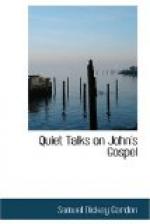There is the feeding of the hungry thousands with a handful of loaves and fish. Was this the real Passover celebration? The multitudes fed by Him who was the Lamb of God and the true Bread of life? while the technical observance was empty of life! It wouldn’t be the only thing of the sort, in ancient times or modern.[32]
Jesus withdraws from the crowds who would like a bread-maker for a king, gets a bit of quiet alone with His Father on the mountainside, and then walks on the water in the storm to keep His appointment with the disciples. Then follows a long disputation and another fine bit of Jesus’ teaching.[33] These two incidents make another distinct group, separated from the previous one by a year on the far side and six months on the hither side. And the contrast continues, between the acceptance by the Galilean crowds and the intensifying opposition by the chief group of Jerusalem leaders.
Then comes the second chief group of incidents. About six months later Jesus returns to Jerusalem for the autumn Feast of Tabernacles. He boldly teaches in the temple in the midst of much opposition, bitter discussion, and concerted official effort against Him.[34] The dramatic incident of the accused woman and the conscience-stricken leaders[35] is followed by a yet more bitter discussion and by the first passionate attempt at stoning.[36]
Then the incident of the man born blind but now blessedly given his sight leads to the bitterest opposition thus far, and the casting of the man out from all religious privileges; and is followed by the rare bit of sheepfold and shepherd teaching.[37] These four incidents make up the second great outstanding group of incidents, and mark the sharpest clash and crisis thus far.
A few months later at another Jerusalem feast called the Feast of the Dedication, comes a second hotly impulsive riotous attempt at stoning, and then an attempt to arrest, both foiled by the restraint of Jesus’ mere presence and personal power.[38] And another connecting link traces His going away beyond the Jordan River, where the crowds gather to Him, and are won to warm personal belief.[39]
Another little gap of a few months passed over in silence, brings the narrative to the third and last chief group of incidents in this part of the book, and so leads immediately up to the great final events of the whole book.
The illness and death of Lazarus draws Jesus back to a suburb of Jerusalem, Bethany. Then the stupendous incident of the raising of Lazarus leads to the official decision to put Jesus to death.[40] And a connecting link of verses tells of Jesus’ cautious withdrawal, of the inquiring crowds coming to the approaching Passover, and of the public notice given that Jesus was under official condemnation.[41]
It is at the home feast given in Bethany as a tribute of love to Jesus that Judas, coldly criticizing a warm act of tender love, and gently rebuked by Jesus, gets into that bad heat of temper out of which came the foul bargaining and betrayal.[42] Another brief connecting link lets us see the crowds more eagerly inquiring for Jesus because of the raising of Lazarus, and the determined priests coolly plotting Lazarus’ death, too.[43]




